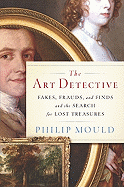
 "If I am honest, what first got me interested in art was the thrill of seizing on things others might have missed or undervalued," Philip Mould admits. That drive and the possibility that there was money to be made propelled Mould into a successful career as he examined paintings closely, developed his talent for hunches and refined his eye for telling details used by master painters. It is one thing to find a dusty framed oil in Granny's attic (it could be worth something, we all wish), but is quite another to discover a Rembrandt, a Thomas Gainsborough or a rare early landscape by John Constable, as Mould has done.
"If I am honest, what first got me interested in art was the thrill of seizing on things others might have missed or undervalued," Philip Mould admits. That drive and the possibility that there was money to be made propelled Mould into a successful career as he examined paintings closely, developed his talent for hunches and refined his eye for telling details used by master painters. It is one thing to find a dusty framed oil in Granny's attic (it could be worth something, we all wish), but is quite another to discover a Rembrandt, a Thomas Gainsborough or a rare early landscape by John Constable, as Mould has done.
Touching on a few of his inspired hunches through the years, Mould recounts the high points with an enthusiasm that will make his fans from BBC's Antiques Roadshow look more carefully at the next unattributed artwork that falls into their hands. Hang on to your hats: it could be, we learn from Mould's own experience, a very valuable Winslow Homer watercolor. So how can we tell if we have something important? Mould is generous with knowledge he has acquired, but from the tales he tells, it is clear that only experts can make the definitive call.
Whether Mould is discussing landscapes by John Constable or disputed portraits of British royalty, he offers tantalizing tidbits of what catches his eye. "Drapery can be as illuminating as handwriting in expressing the traits of individual artists," he confides. Details, like jewelry, in a painting can also be revealing enough to define a portrait as being of Catherine Parr, Henry VIII's sixth and last wife, not Lady Jane Grey, as previously believed.
Attribution usually takes more than one quick glance, as demonstrated in the case of an odd, small portrait of Rembrandt. The portrait exhibited a few characteristic Rembrandt touches, but areas of sloppy execution raised questions about whether this was the real thing. Using up-to-date analytical tools (dendrochonology can date wood panels used in paintings, for example), experts were able to determine that the self-portrait had been painted over with additional detail. You may ask why some lunatic would mess with a Rembrandt. The surprising answer is the people in Rembrandt's studio often "updated" self-portraits done by the master if the works did not sell quickly enough. Mould describes the painstaking restoration process that revealed the newly "discovered" Rembrandt with a connoisseur's delight; the conclusion will send treasure hunters everywhere up to the attic for another look-see--at auction, the self-portrait brought £7 million (about US$10.5 million).--John McFarland
Shelf Talker: A lively survey of great paintings found in obscure places and the money that could be made if the trove in the attic is, in fact, golden.

